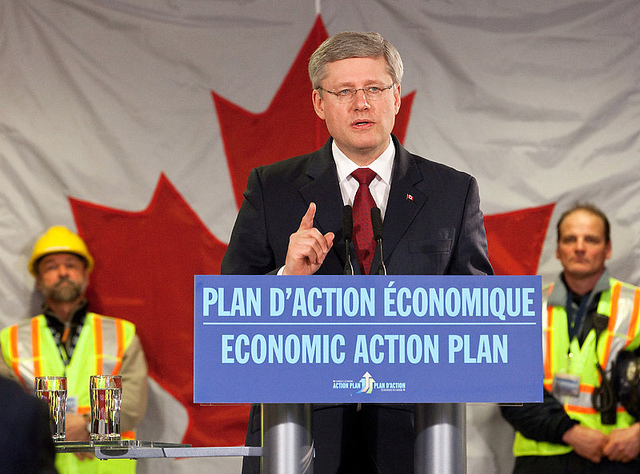On December 7, the Conservative Party of Canada marked its 10th year of operations. With Stephen Harper subject to gossip about leaving office and the party slumping in the polls, celebrations were limited to a top 10 list, buried behind a Stand With PM Harper sign-up page on the CPC website.
Harper himself jetted off to South Africa surrounded by former governors general, and prime ministers.
Where once Conservative were under orders not to be seen with Brian Mulroney, thanks to brown bags of unexplained cash the former PM collected from lobbyist Karlheinz Schreiber, now Harper was looking to boost his own popularity by including Mulroney in the photo-ops.
Created in 2003 when the Western-based Reform Party (re-invented as the Canadian Reform Conservative Alliance) merged with the remnants of the Progressive Conservatives (which never recovered from the Mulroney years), CPC prospects looked poor. Yet it formed its first minority government three years later, and despite initially mishandling a major recession, the CPC won a majority government in its seventh year of existence, largely by promising jobs, growth and prosperity.
Thanks to Bank of Canada monetary policy, low interest rates have boosted the stock market. But the much awaited business investment boom that easy money was designed to facilitate has yet to occur. On what matters most to people — jobs and incomes — despite bundles of Harper government advertising paid for by voters proclaiming the contrary, the Canadian economy is limping badly.
The contradictory Canadian economic outlook was revealed recently when the Bank of Montreal reported record profits of $4.3 billion and then laid off 997 workers.
The number 1 political question facing the CPC as it enters its second decade is how long will it be before observers see through the Harper government claims about Canada’s strong economy?
From November 2012 until November 2013 economist Andrew Jackson reports that all the jobs created in Canada were in the low-paying, economically insecure, sales and service occupations.
The CPC are the bad jobs party.
An in-depth report done in 2013 by McMaster University and the United Way looked at how people living in the Greater Toronto/Hamilton area are making out in today’s economy. Researchers found barely one-half of the working population had what could be called a good job, meaning permanent employment with benefits; the rest lived a precarious existence.
In Canada’s largest urban setting the workforce is broken in half, with the poor and the near poor facing complex health and family problems caused by economic insecurity.
Unifor economist Jim Standford focused on what is happening to employment among working-age Canadians. His finding show that job creation in Canada has stalled, barely keeping up with the growth in population. Prime age workers are exiting the job market, leaving the employment rate (the percentage with a job) at its lowest since 2002.
More people than it appears have no job. Using widely available statistics, Angella MacEwen of the Canadian Labour Congress has shown that the real Canadian unemployment rate is about double the official unemployment rate.
Numbers from last June showed the jobs situation was worse in vote-rich Ontario. Add the people working part-time looking for full-time work and the people who have quit looking for jobs that do not exist, to the 8.6 per cent in Ontario who are officially unemployed, and the real rate of unemployment in Ontario is 18.4 per cent, over twice the rate heard on the radio or reported in the press.
Instead of taking the dire situation facing the unemployed into account when deciding who gets access to EI benefits, analysis done by Angella MacEwan points to the CPC using EI premiums to try and balance the budget.
Canadians poorly paid throughout their working lives are now facing retirement. The Harper government’s present to retirees is to push off eligibility for the Old Age Pension to age 67, and block a virtual provincial consensus to increase retirement payouts under the Canada Pension Plan.
Young workers face serious difficulties in today’s job market as both the unemployment rate and the income statistics consistently show. The CCPA Ontario Office found in Toronto the youth unemployment rate is over 21 percentage points higher than the adult rate.
The Harper government pays youth little attention, smugly assured that young people stay away from the polls at election time in much greater numbers than older Canadians.
The Behind the Numbers blog ran a series last week by Kayle Hatt (CCPA 2013 Andrew Jackson Progressive Economics Intern) that shows claims made by the Harper government in the latest throne speech (and repeated in the CPC top 10 list) about Canada having the strongest economy in the G7 are exaggerated.
The CCPA Economic Recovery Report Card grades Canada “F” for precarious employment.
The CPC rely on erroneous claims getting routinely repeated, without accompanying critical comment. This can only last so long. Even some CPC backbenchers have created the Committee 2012 to vent displeasures.
Either Canada’s job performance starts to look like what the CPC says it looks like or the party will be punished for bragging, but not delivering on the economy.
Duncan Cameron is the president of rabble.ca and writes a weekly column on politics and current affairs.
Photo: pmwebphotos/flickr



